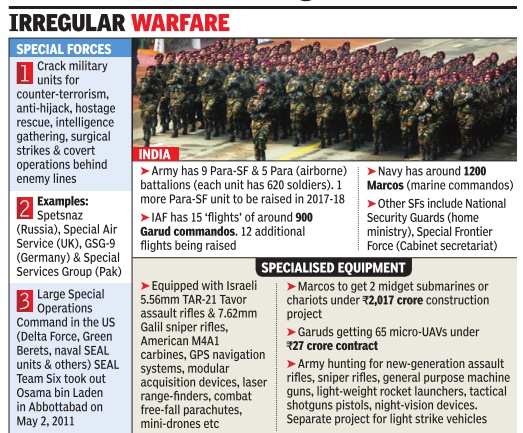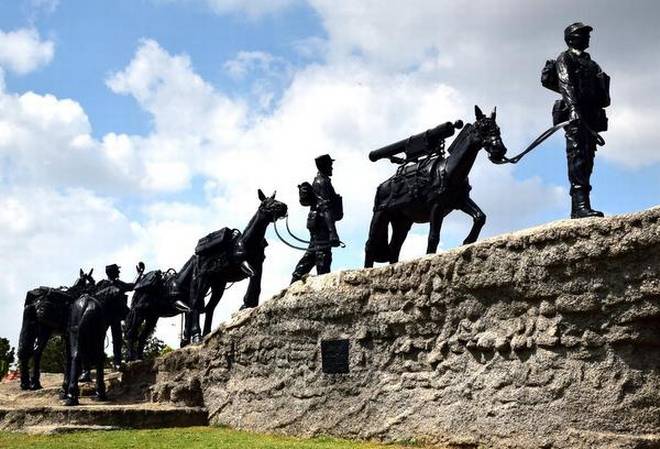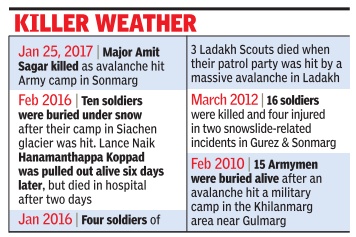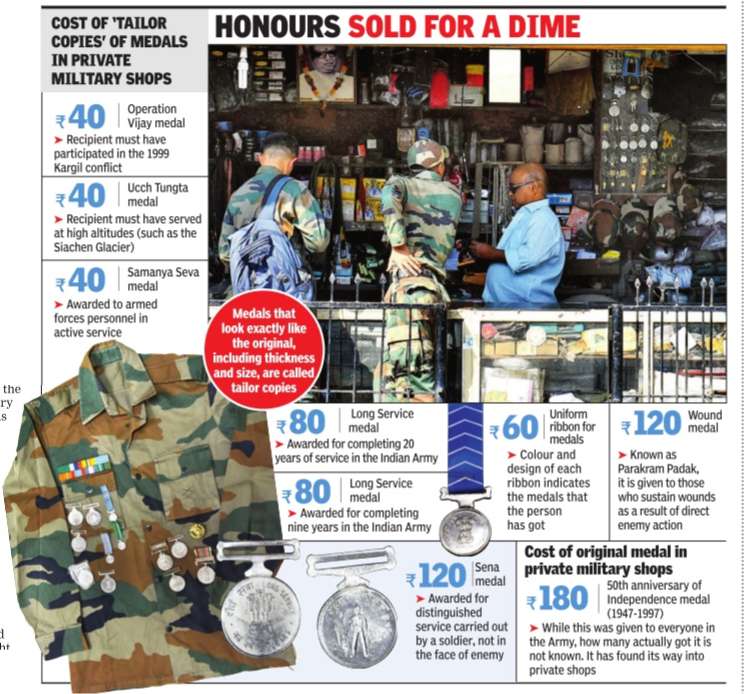Indian Army
(→Bengaluru: First Motorised Transport Heritage Park) |
(→Medals) |
||
| Line 69: | Line 69: | ||
This reporter could even buy the replica of a medal given for participating in the Kargil war, codenamed Operation Vijay; the Samanya Seva med al, for designated operations; and the Uchh Tungta medal, for serving at high altitude. All the three medals came with the appropriate ribbons. | This reporter could even buy the replica of a medal given for participating in the Kargil war, codenamed Operation Vijay; the Samanya Seva med al, for designated operations; and the Uchh Tungta medal, for serving at high altitude. All the three medals came with the appropriate ribbons. | ||
| + | |||
| + | = Motorised Transport= | ||
| + | == Heritage Park at Bengaluru/ 2016== | ||
| + | [http://www.thehindu.com/news/cities/bangalore/Army-immortalises-its-old-workhorses-in-Bengaluru/article16765132.ece ''The Hindu''], December 6, 2016 | ||
| + | [[File: An exhibit at the Army’s first Motorised Transport Heritage Park in Bengaluru. .jpg|An exhibit at the Army’s first Motorised Transport Heritage Park in Bengaluru. ; Picture courtesy: [http://www.thehindu.com/news/cities/bangalore/Army-immortalises-its-old-workhorses-in-Bengaluru/article16765132.ece ''The Hindu''], December 6, 2016|frame|500px]] | ||
| + | |||
| + | |||
| + | The Indian Army is on the hunt, and this is no ordinary ‘mission’. It is tracking down decommissioned vehicles that it had once used through its vibrant history. The aim is to curate jeeps, trucks, among other vehicles, at the Army’s first Motorised Transport (MT) Heritage Park, which was inaugurated in Bengaluru. | ||
| + | |||
| + | The park, a first of its kind resting place for the Army’s most popular transport vehicles, is an endeavour of the officers of the Faculty of Transport Management, located at the Army Service Corps (ASC) Centre and College, Old Airport Road. The first five vehicles to be displayed at the park were put together painstakingly from 2015 in New Delhi before being transported by road to Bengaluru. | ||
| + | |||
| + | “This is a memorial for the silent transporters of the Indian Army. The idea is based on a similar museum in England. We are trying to get models of all old vehicles used in the Army, but it’s tough as many have been auctioned or scrapped. In the future, the park will also include models of all vehicles which the Army will stop using, like the Ambassador which is slated to be stopped five to six years from now,” said Lieutenant General S.P.S. Katewa, AVSM, Commandant ASC Centre and College. | ||
| + | |||
| + | At present, the park includes a Jeep Willys 4X4, a 3-tonne Shaktiman truck, a Nissan Patrol (JONGA), a Tata-Mercedes Benz (TMB) truck, and a 1-tonne Vahan truck. | ||
| + | |||
| + | '''Memorial for animals''' | ||
| + | |||
| + | |||
| + | The ASC Centre also hosts a memorial for pack mules and other animals that the Supply Corps uses extensively. “There was talk during the Kargil War of wanting to cut down on the use of animal transport, but with hard-to-reach front lines in the eastern borders with China, we still continue to use these animals for transport. We are the only corps to use pack mules and we wanted to raise a memorial for these animals as well,” a senior ASC officer said. | ||
| + | |||
| + | The public have to apply for prior permission to view the memorials. “We bring children from schools and colleges here as part of the ‘Know your Army’ programmes. We can permit the public on special days, with proper security arrangements,” Lt. Gen. Katewa said. | ||
=Mountain strike corps= | =Mountain strike corps= | ||
Revision as of 21:34, 23 April 2017
This is a collection of articles archived for the excellence of their content. |
Contents |
Animals used by the Army
Retired army dogs , horses and mules to get new lease of life
In what could be a new lease of life for Indian Army dogs, horses and mules which are routinely put to sleep after their retirement, the force is building special facilities to house them and are in talks with NGOs for giving them up for adoption.
However, not many NGOs in the country have the facility to take care of about 1000 horses and mules that retire every year.
“Every year about 50 dogs and about 1000 horses and mules retire. The Army is building special facilities in different places in the country to house them after their retirement,” defence sources said.
They said that while dogs can easily be taken up by people through adoption, keeping horses and mules is a big problem.
“Maintaining cost for horses are high. Not to forget the space and infrastructure that would be needed,” sources said.
The government had in September informed the Delhi High Court that it would come out with a policy on the issue within six months.
The practice of euthanasia will be stopped under this policy, which will also give details of the arrangements to be made for these animals after they retire, the High Court was told.
Additional Solicitor General (ASG) Sanjay Jain said the policy was being formulated and the issues raised in a writ petition, which sought an end to the practice,were under active consideration.
Though a final policy is yet to be adopted, the Army has ceased further killing of ageing animals, except for those suffering incurable, terminal diseases and injuries.
The army has also been asked by the Defence Ministry to deal with the cases of animals suffering from incurable diseases, injuries and terminal diseases as per the provisions of Section 13 (3) of the Prevention of Cruelty to Animals Act, 1960.
The development came in the backdrop of the court’s direction to seek instruction in the matter relating to killing the dogs which have served national security by sniffing bombs, hunting down enemies, locating secret places and fetching evidence.
The Army generally uses Labradors, German Shepherds and Belgian Shepherds, depending on the altitude and weather, besides the nature of assignment which may include routine patrol to explosives detection.
The court had earlier observed that the respondents had admitted that the current practice of putting Army service dogs to sleep was against the provisions of the Prevention of Cruelty to Animals Act, 1960. (PTI)
’Commandos’ (Special Forces)
See graphic.

Medals
Non-gallantry medals can take 10 years to arrive
Sushil Rao , Non-Gallantry Medals Take As Long As 10 Yrs To Come, Jan 25, 2017: The Times of India
Army personnel, both retired and serving, awarded for their service are forced to buy replicas of the medals from private shops as the Army takes several years to deliver the originals.
The replicas, which are called `tailor copies', can be bought for as low as Rs 40 to Rs 180 from private outlets at Lal Bazar, Regimental Bazar, Mehdipatnam and Golconda in the twin cities of Hyderabad and Secunderabad. Defence ministry sources in Delhi confirmed that the backlog of non-gallantry medals runs as far back as 10 years.
A TOI investigation has revealed that one would have to shell out as less as Rs 2,500 for a complete uniform with all the medals, complete with the badges.Except for the gallantry awards, a `tailor copy' of practically every medal is up for sale.However, gallantry medals, which have the name and Army number of the recipient engraved on them, cannot be bought from a private shop.
“Yes, I bought nine out of 10 medals from private shops,“ admits Mohammed Rafee, who put in 24 years of service in the Army . Rafee was awarded 10 medals but was given only one by the Army . He joined the Army as a sepoy when he was 17 and a half years old. He rose through the ranks by virtue of the number of years that he put in and finally retired as havildar.
“I should have got my medals at the time they were to be given to me,“ Rafee says.Among the medals that he was awarded were the ones for nine years of service, 20 years of service, serving in Jammu and Kashmir, and for serving at high altitude and other places.
Former Army personnel say lack of coordination among various wings of the Army is the reason why medals are not reaching recipients on time. “The Army Postal Services should deliver the medal to the personnel wherever they are. One problem could be tracing a person if he has been transferred,“ Rafee says.
The market for medals also poses a grave security threat, with the tailor copies available for sale to any willing buyer. This reporter was able to buy several `tailor copies' not produced by the government mint. The shops also sell badges that are to be pinned to the Army uniform.
This reporter could even buy the replica of a medal given for participating in the Kargil war, codenamed Operation Vijay; the Samanya Seva med al, for designated operations; and the Uchh Tungta medal, for serving at high altitude. All the three medals came with the appropriate ribbons.
Motorised Transport
Heritage Park at Bengaluru/ 2016
The Hindu, December 6, 2016

The Indian Army is on the hunt, and this is no ordinary ‘mission’. It is tracking down decommissioned vehicles that it had once used through its vibrant history. The aim is to curate jeeps, trucks, among other vehicles, at the Army’s first Motorised Transport (MT) Heritage Park, which was inaugurated in Bengaluru.
The park, a first of its kind resting place for the Army’s most popular transport vehicles, is an endeavour of the officers of the Faculty of Transport Management, located at the Army Service Corps (ASC) Centre and College, Old Airport Road. The first five vehicles to be displayed at the park were put together painstakingly from 2015 in New Delhi before being transported by road to Bengaluru.
“This is a memorial for the silent transporters of the Indian Army. The idea is based on a similar museum in England. We are trying to get models of all old vehicles used in the Army, but it’s tough as many have been auctioned or scrapped. In the future, the park will also include models of all vehicles which the Army will stop using, like the Ambassador which is slated to be stopped five to six years from now,” said Lieutenant General S.P.S. Katewa, AVSM, Commandant ASC Centre and College.
At present, the park includes a Jeep Willys 4X4, a 3-tonne Shaktiman truck, a Nissan Patrol (JONGA), a Tata-Mercedes Benz (TMB) truck, and a 1-tonne Vahan truck.
Memorial for animals
The ASC Centre also hosts a memorial for pack mules and other animals that the Supply Corps uses extensively. “There was talk during the Kargil War of wanting to cut down on the use of animal transport, but with hard-to-reach front lines in the eastern borders with China, we still continue to use these animals for transport. We are the only corps to use pack mules and we wanted to raise a memorial for these animals as well,” a senior ASC officer said.
The public have to apply for prior permission to view the memorials. “We bring children from schools and colleges here as part of the ‘Know your Army’ programmes. We can permit the public on special days, with proper security arrangements,” Lt. Gen. Katewa said.
Mountain strike corps
17 Corps
The raising of the corps
The Times of India, May 04 2016
Use of war reserves for new corps suicidal
Rajat Pandit
A parliamentary panel has sounded the alarm at the way the Army is being forced to cannibalise its existing reserves to raise the new mountain strike corps needed to acquire effective conventional deterrence against China.
“Milking existing resources, which in some cases are not fully up to authorisation, is suicidal,“ said the parliamentary standing committee on defence in its latest report, tabled on Tuesday .
The committee asked the defence ministry to “critically examine“ the issue and report back within two months.“The committee feels raising of the mountain strike corps is in the interest of national security and recommends that necessary funds for infrastructure development are released for it,“ it said.
In a series of reports, TOI has earlier highlighted how the 1.18-million strong Army was struggling to raise the new mountain strike corps, the 17 Corps, by dipping into its critical war wastage reserves (WWR) in the absence of dedicated funding. This becomes all the more alarming since the Army cannot fight a war beyond 15 days because of crippling shortages in its ammunition stocks, especially for tanks, air defence weapons and anti-tank guided missiles.This, when the approved norm is to hold ammunition for 40 days of “intense“ fighting under the WWR since it can prove critical in winning wars.
“It will not be possible for the Army to reach 100% WWR even by 2019-2020. Moreover, operational deficiencies continue in howitzers, helicopters, air defence weapons, night-fighting capabilities and the like,“ said an official.
The raising of the 17 Corps, with 90,274 additional soldiers, was approved by the UPA-II regime in July 2013 at a cost of Rs 64,678 crore spread over eight years till 2020-2021. But defence minister Manohar Parrikar has repeatedly attacked UPA for sanctioning the 17 Corps in an “arbitrary manner“ without any financial allocation or proper planning. The proposal for another Rs 26,155 crore for infrastructure and capability development along the northern borders is yet to be even approved.
Parrikar has also reiterated that the Army needs to cut down its non-operational flab and manpower in the face of escalating wage and pension bills. Even as a high-level committee is now being set up to look into this, the Army says there is very little scope for manpower cuts till it inducts “cutting-edge technology , platforms and systems“ to offset “boots on the ground“ along the two long unresolved borders with China and Pakistan.
2010-17: See graphic.

Supersession in appointments
Dinakar Peri, Seniority avoided in appointments, January 18, 2017: The Hindu
Please see:
Seniority done away with in another Army appointment
After setting aside the guiding principle of ‘seniority-cum-merit’ in the appointment of General Bipin Rawat as the Chief of Army Staff, in appointing the Engineer-in-Chief, who heads the Military Engineer Services and the Corps of Engineers, the government has superseded the seniormost officer Lt. Gen. Vishwambhar Singh, Director General Weapons & Equipment. Instead, it has appointed Lt. Gen. Suresh Sharma, who was Director General-Border Roads.
The move comes after the government, in a surprise move, superseded Eastern Army Commander Lt. Gen. Praveen Bakshi in the appointment of the 27th Army Chief, which had caused considerable concern in the service.
The present Engineer-in-Chief, Lt. Gen. Sanjiv Talwar, is set to retire by the end of the month, and the designate Lt. Gen. Sharma is supposed to take charge on February 1. The appointment has been cleared by the Appointments Committee of the Cabinet (ACC) headed by the Prime Minister.
The Engineer-in-Chief is an advisor to all three service chiefs. “Generally, the appointments are by done on the principle of ‘seniority-cum-merit’. Technically, Lt. Gen. Singh is senior, but it was the government’s call,” a source said.
An engineering officer pointed out that it has been the tradition to appoint the seniormost officer to be the Engineer-in-Chief. “At least in my memory, the seniority has not been scuttled. This was very surprising,” he said.
As per procedure, the Army Headquarters forwards a list of eligible officers to the Defence Ministry. The Defence Minister then puts down his recommendations and sends the file to the ACC, which makes the final selection.
Of the two officers, Lt. Gen. Singh is from the architects cadre, while Lt. Gen. Sharma is from the engineers cadre. “We were told that they preferred someone from the engineering stream at the top post,” a civilian officer in the Corps of Engineers said. Speaking last week, Gen. Rawat said that the issue of choosing Army Commanders through a selection board rather than by seniority alone would be debated. “I believe in a system of consensus. This is an issue which has not been addressed earlier but we will certainly take up with the Army Commanders to see how they feel,” he had said.
